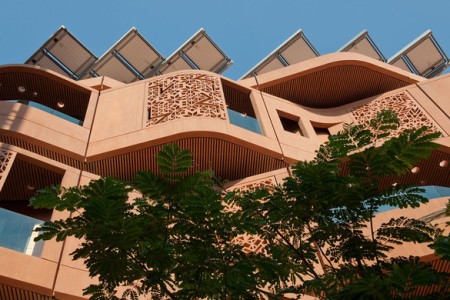Masdar, Abu Dhabi’s multi-faceted renewable energy company caught the attention of the world press when it announced in 2006 that it was building the world’s first high-tech large-scale carbon-neutral development city in Abu Dhabi costing about $18 billion.

The Masdar City is awalled cleantech hub comprising several wind towers, solar panels, local building materials, and a futuristic driverless personal rapid transit system.
Currently Masdar has completed the construction of a number of buildings to house retail outlets, restaurants, a library, and structures for the Masdar Institute that exclusively deals with sustainability, science, and alternative energy. Initially, the all-electric driverless personal rapid transit (PRT) pods, which run on magnets in the roadways, were meant to be the only form of transportation for both residents and visitors. Though this plan hasn’t really materialized, Dr. Sultan Al Jaber, the CEO and the managing director of Masdar explains that the PRT will be possible in the foreseeable future. He states that as there isn’t a model available to base on or acquire from, hence lessons are learnt only by experience and delays are inevitable.
Al Jaber believes that by 2025 Masdar City will have as many as 40,000 residents and hundreds of businesses. In the next five-year period, 400,000 to 500,000 sq.m will be the built area. A recycled material and FSC-certified wood industries is being developed. Masdar is also a top participant in the Pearl Rating System, a building code in the UAE that is corresponding to LEED.
Compared to the average consumption in the UAE, in 2011, Masdar City cut water consumption by 54%, electricity consumption by 51%, and cooling requirements by 50%. Despite the global economic situation and lack of a model, Masdar has shown the world the hazards and potential successes of attempting to actualize a perfectly sustainable city. It has encouraged other cleantech-focused cities to take shape in Denmark, China and Sweden.
Source: http://www.masdar.ae/en